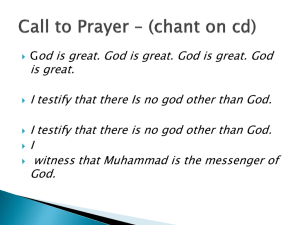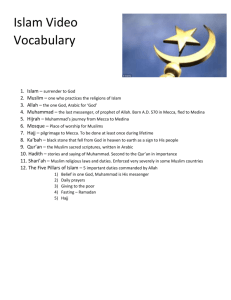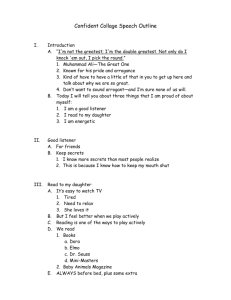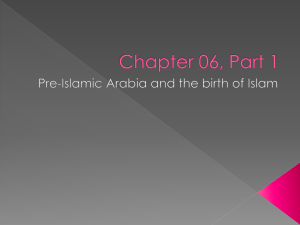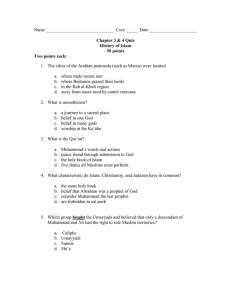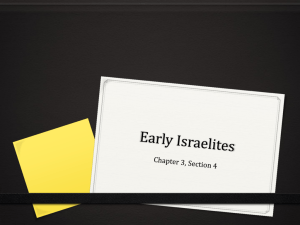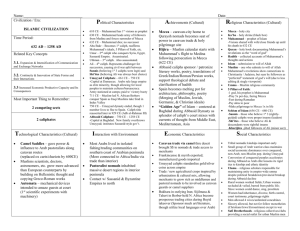The First Global Civilization
advertisement
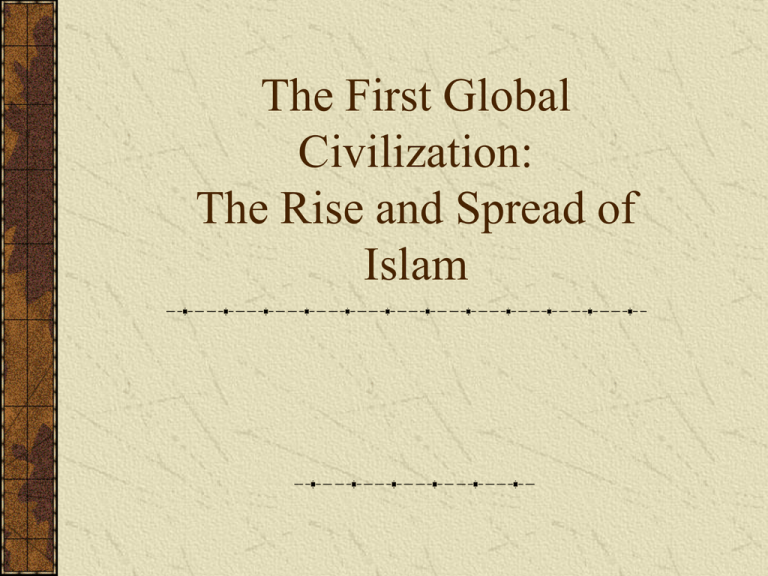
The First Global Civilization: The Rise and Spread of Islam The Arabian Peninsula is a crossroads of three continents: Africa, Europe, and Asia Only small areas of the peninsula can support agriculture, the rest is a desert Inhabited by nomadic Arab herders Nomads were called Bedouins and were organized into tribes and clans Clans provided security and support in the harsh conditions Eventually these clans became the core of armies who would build a huge empire in the 600 and 700’s. Bedouins ideals of courage, loyalty, and warrior skills would become part of the Islamic way of life By the 600’s many Arabs had chosen to settle in the oasis or market towns Larger towns developed on the western coast of Arabia and were market towns for local, regional, and long-distance trade good By 600 Arabia was connected with all the major trade routes of the ancient world They used caravan routes, had north to south trade, and were part of the Silk Roads Transported spices and incense from Yemen to the west. They also carried information and ideals in addition to products! By 600 cities such as Petra and Palmyra had become prosperous trading centers The city of Mecca became a very important trade stop Caravan stopped in Mecca and brought religious pilgrims who came to worship at an ancient shrine in the city, Ka’aba Associated this house of worship with Abraham, a believer in one God. Over the years , they had introduced the worship of many gods and spirits in the place. The Ka’aba contained 360 idols brought by many tribes. God = Allah in Arabic The belief in one god was not new to Arabs, many Jews and Christians had practiced their religion in the area Muhammad was born into a powerful Meccan family Muhammad came into this mix around 570 CE Orphaned at the age of six he was raised by his uncle. He received little schooling and began working in caravan trade as a young man He became a trader and business manager for Khadijah, a wealthy businesswoman When he turned 25 he married Khadijah He worked on the caravan routes and came into contact with Judaism and Christianity Muhammad took a lot of interest in religion and spent much time alone in prayer and meditation At 40,Muhammad’s life changed overnight when a voice called to him while he meditated in a cave outside of Mecca According to Muslim belief the voice was the angel Gabriel who told Muhammad that he was a messenger of God “What shall I proclaim? Asked Muhammad the voice answered: Proclaim! In the name of they Lord and Cherisher, who created man out of a mere clot of congealed blood. Proclaim! And thy Lord is most bountiful. He who taught (the use of) pen taught man that which he knew not Clans Clans fought for possession of watering place and grazing lands (rivalries). Survival depended on cooperation within clan. Could end up in battle over mere insults. Mecca and Medina were extensions of the tribal culture and their populations were linked by kinship to Bedouins. Mecca was found by the Umayyad clan of the Quraysh Bedouin tribe. Women enjoyed greater freedoms, played economic role (milking camels to weaving), traced descents via mother, bride-prices, not secluded, not equal. When merchant elite was created women’s roles declined! Men could be polygamous but women monogamous Little art culturally, focus on poetry and stories Religion Religion was a blend of animism and polytheism. Some tribes recognized a supreme god, Allah. But seldom prayed to him. Like less abstract gods who seem more relevant to their lives like Hubal or the moon god. Religion did not appear to have a lot to do with ethics rather standards of morality were set in tribal customs an unwritten codes After much soul-searching, Muhammad came to believe that the Lord who spoke to him through Gabriel was Allah. He believed that he was the last of the prophets and began teaching that Allah was the one and only God and that all other gods must be abandoned The people who followed Muhammad’s teachings and beliefs are called Muslims. In Arabic the term Islam means “submission to the will of Allah” Muslim means “ one who has submitted” His wife and several friends were his first followers…by 613 Muhammad began preaching in Mecca At first Meccans had problems with him b/c of the pilgrimage industry and they did not want to neglect the Arab gods. Some of his early followers were beaten and stoned So Muhammad left Mecca and settled in the town of Yathrib (200 miles away). He found many followers here. In addition to a religious leader, he was accepted as a political leader too! He settled quarrels between Bedouin clans of the town. His wisdom and skills politically won him new followers. Yathrib was later renamed Medina meaning “city of the Prophet” Many Bedouin tribes converted to Islam. Providing Muhammad with a large army. In the eyes of Umayyad notables Muhammad successes made him a great enemy. In the past they attempted to kill him. New faith and unwelcomed competition Medina vs Mecca. Battled for years and 630 Muhammad and 10,000 men marched to Mecca. Meccans surrender. Treaty of Quraysh in 628 Muhammad destroyed the idols at Ka’aba and held a call to prayer there. Most Meccans quickly converted to Islam after there defeat and became part of the Muslim religious community, umma. Muhammad died 2 years later Beliefs/ Practices There is only one God, Allah There is good and evil and individuals are responsible for there own actions Holy book of Islam is the Qur’an Believe in final judgment before Allah where they will enter heaven or hell Do not separated personal and religious lives Customs, morals, and laws that control Muslims Forbidden to eat pork or drink wine (alcohol) Friday afternoon set aside for communal prayer Has no priests or central religious authority Scholar class called the ulama, learning and law 5Muslim Pillars you must carry out these duties Faith- “there is no God but Allah and Muhammad is the Messenger of Allah Prayer-Five times a day towards Mecca Alms- responsibility to support the less fortunate Fasting-During the Islamic holy month of Ramadan, Muslim fast. They eat and drink nothing between dawn and sunset. Eat at end of day Pilgrimage-All Muslim must perform the hajj or pilgrimage to Mecca at least once in their life. During the pilgrimage events in Mecca all Muslims dress the same to appear as equals before God Authority rests with Allah, who expressed his will to Gabriel, who revealed it to Muhammad. The Qur’an came from writing down Muhammad teachings and prayers Qur’an is written in Arabic and Muslims considered the Arabic version to be the true word of God. Only Arabic can be used in worship and this is why the language spread so quickly Not only did Muhammad provide the Qur’an, he provided an example for other Muslims to follow Sunna (Muhammad’s example) These ideas and laws were assembled into a body of laws called the shari’a. Why it worked so well Popular because it transcended clan and class divisions It was a monotheistic religion from their people with no intermediaries between the individual and God Possibility to end vendettas and feuds Umma created political unity Skills of the Bedouins of war could be used to conquer other lands and create the first global civilization! Ethical system that helped heal the deep social rifts within Arabic society. Dignity of all believers, equality before Allah (egalitarianism), moral codes, responsibility for the poor, and being kind and generous Qur’an laid the foundations for an extensive law code to regulate all aspects of Muslim life. (last judgment) Crisis after Death of Muhammad in 632 CE Many Bedouin tribes renounced Islam after the death of Muhammad Muhammad left no direction over succession and this began to be disputed Caliph=political and religious successor of Muhammad Several choices, Ali (Muhammad’s cousin) thought to be too young though and Abu Bakr (a close friend and early follower) Abu Bakr became the first caliph. Those who knew Muhammad were called the rightly guided caliphs. He united Bedouin tribes through the Ridda Wars. Under Umar, the second caliph, Syria and lower Egypt were conquered from the Byzantine Empire. He also took parts of the Persian Empire Third caliph, Uthman from the Umayyad clan was murdered. The murder of Uthman in 656 triggered a civil war and crisis over succession Uthman was chosen caliph in 644. The reasons for his selection are unclear; it may be partly due to his willingness to continue Umar's policies, partly due to his Umayyad lineage. During his twelveyear reign, grievances which had been suppressed under Umar's caliphate came to the surface. He was accused of nepotism, favoritism, misadministration, and religious innovation by his detractors, which included the man who would become the fourth caliph, Ali. Uthman was murdered in 656 by a group of discontented Egyptians. Umayyads rejected Ali’s claim and swore to revenge when Ali failed to punish the assassins of Uthman. Ali was related to Muhammad and a strong warrior. In 656 in the battle of the camel, he lead a victory against the Umayyads By 657 at the battle of Siffin Ali was on the verge of defeating the Umayyads when he was won over by a plea for mediation He accepted negotiations and because of this many of his supporters renounced him! Umayyads regrouped their forces and in 660 under the leadership of Mu’awiya challenged Ali’s position by claiming himself caliph of Jerusalem A year later, Ali was assassinated and his son, Hasan was pressured by the Umayyads to renounce his claim to the caliphate. The question over succession deeply divided the Islamic world…even to this day! The split between Sunnis and Shi’a Sunnis backed the Umayyads Shi’a supported Ali and Muhammads relatives The hostilities between the two groups continued as the Umayyads and Ali’s second son, Husayn struggled for power. Husayn was killed in 680 at Karbala Shi’a only recognized Ali as a caliph! Differences not only in succession but also in beliefs, rituals, and laws developed between the Sunnis and Shi’a Also sects within the Shi’a community over Ali when he agreed to arbitration with Umayyads Islamic Empire Expands Umayyads seize power and extend the Arab empire By 633 Arabia under Islamic banner turned their eyes outward beyond the peninsula Stunning conquests of Mesopotamia, north Africa, and Persia Empire ruled by small Arab warrior elite led by the Umayyads and important clans Abu Bakr = Ridda Wars –united Arabia and oversaw raids into Iraq, Syria, and eastern Egypt Wanted to raid for booty and then retreat but the initial probes into the lands revealed their vulnerabilities Byzantine Empire and Sasanian Empires weak Islamic invaders driven by a sense of common cause and purpose (Islam), standing up against non-Arab rulers, to release pent-up energies of the Bedouins, and the promise of a share in the booty by raids and tribute. However, they were not driven by a desire to win converts! They would have to share the booty and Muslims were exempt from some taxes. Thus the idea of jihads or holy wars launched to forcibly spread the Muslim faith are false Most vulnerable empires were in the Middle East, Sasanian which was the Persian Empires Sasanian empire ruled by an emperor controlled by the elites. Elites exploited poor, Zoroastrianism official religion while the popular religion of Mazdak was suppressed. Warriors and defective Arabs combined to lead to the quick fall of the Sasanian Empire 651 last of the Sasanian ruled murdered Byzantine Empire stronger than Sasanian. Support by defective Arabs and Christian sects (didn’t support the orthodox Byzantines-taxes them and persecuted other Christians as heretics) Syria, Iraq, Palestine, Egypt, and Mediterranean. Were dominant with their navy! Helped them conquer other areas of North Africa and Italy Byzantine Empire still existed, but lost much power and some of its provinces to the Arab invaders! After the civil war Arab conquests continued in the late 7th century Central Asia, Northwest India, Spain, dominated the Mediterranean Political center of empire was not Mecca, but Damascus in Syria under the Umayyads Umayyads tried to block Muslims and nonMuslims. However, this happened. Plus many individuals just converted to the religion of Islam voluntarily! Mawali=Muslim convert Still had pay taxes including sometimes the jizya (head tax) Umayyad era did not have many conversions due to these factors. Most people were the dhimmi or people of the book (Christians and Jews) Dhimmi religions tolerated, but they were required to pay taxes Easier to rule due to this toleration b/c many had been oppressed by former overlords Women At first women enjoyed many rights Qur’an stressed the moral and ethical dimensions of marriage Muhammad showed kindness and concern for his wives and daughters Encourage marriage rather than commercial loving Denounced adultery, forbade infanticide of girls, marry up to 4 wives, no multiple marriages if husband could not support them. Equality before Allah. Many important information recorded by women. Umayyad Fall Became more concerned with luxury and the good life. Caliph’s had very large harems! Instead of fighting in the early 8th century these caliph retreated to their palaces to live it up. Muhammad advocated frugal and simple lives. Began to alienated Muslims. Warriors began settling and marrying locals. They became angry b/c of be governed by a caliph so far away and they were not getting a cut of the booty. Umayyads were seen as corrupt and decadent. Many warriors settled in the oasis town of Merv. In 740 the Umayyads tried to introduce new troops here which sparked a revolt Fall The revolt spread! By 747 Frontier warriors challenged the Umayyads under the banner of the Abbasids. Muhammads uncle, al-Abbas (descendants) Shi’a join forces with the Abbaids to fight the Umayyads Mawali soon joined Battle of the River Zab in 750-(by the Tigris river) and the Abbaids won and captured the Umayyad capital! Abu al-Abbas invited the members of the Umayyad family to a banquet afterwards where he had all of them slaughtered so that the could not make claims to the position of caliph Nickname al-Saffah meaning the blood shedder! Rebel groups overthrow the Umayyads in 750. The most powerful was the Abbasids who took control of the empire The Abbasids murdered all members of the remaining Umayyad family One member escaped and set up control in southern Spain. They were known as the Berbers. The Berbers were lead by Jabal Tariq. Gibraltar is named after him. The Berbers advanced north within 100 miles of what is today Paris before losing in the Battle of Tours in 732. If they would have won all of Europe would most likely be Muslim. They resettled in southern Spain Abbasids moved the capital once again to Baghdad. This was a strategic location for trade as well as information. The government was set up into departments and managed Diplomats were sent out around Europe, Africa, and Asia They ruled from 750-1258 They keep power by consulting many religious leaders, but failed to keep complete control. Independent Muslim states with local leaders rose up Example: Fatimid Dynasty (after Muhammad’s daughter) began in North Africa and spread. They were part of the Shiites (claiming heritage from Fatimid and her husband Ali) Their capital was Cairo after they took over Egypt Shiism unified the group They declined due to losses to the Normans and Crusaders in the 11th century. The Abbasids conquered Egypt in 1171 Abbasids After the murders the grandson of the Umayyad caliph fled to Spain. After the Abbasids took power they started to reject many of their former allies, especially Shi’ism. They thought they had a heretical view of Islam New capital in Baghdad, Iraq Caliph built large places and harems Created a more bureaucratic form of government for the Islamic empire (Wazir) Achievements Economic growth Mosques centers of learning Took older knowledge of peoples such as the Greeks and kept. Map Timeline of Empire in Middle East: MAP http://www.vam.ac.uk/vastatic/microsites/1342_islamic_middle_east/map/


